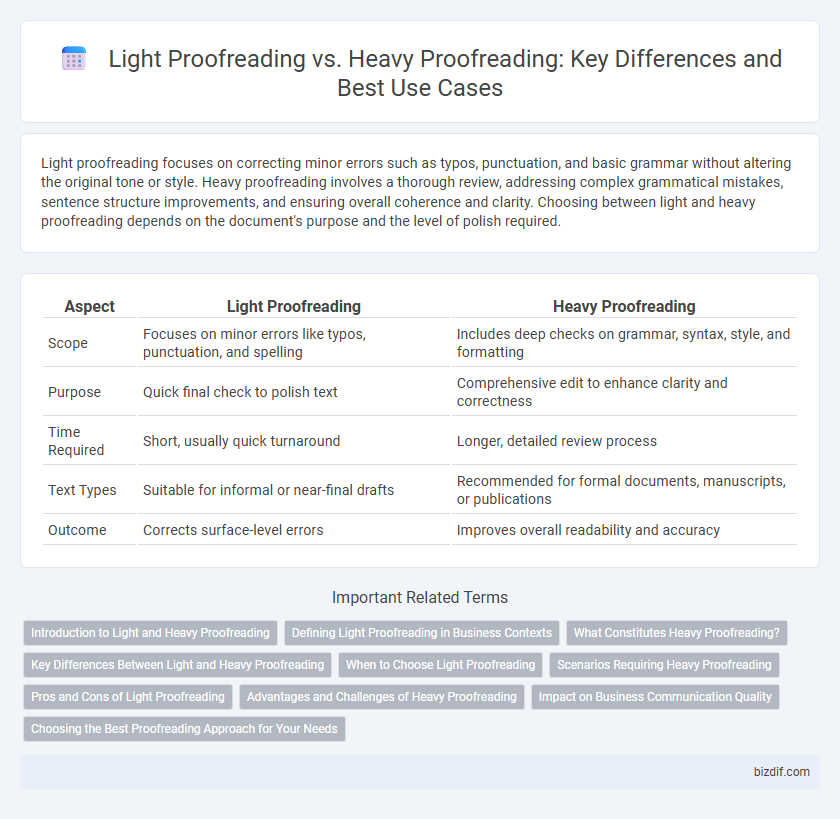Light proofreading focuses on correcting minor errors such as typos, punctuation, and basic grammar without altering the original tone or style. Heavy proofreading involves a thorough review, addressing complex grammatical mistakes, sentence structure improvements, and ensuring overall coherence and clarity. Choosing between light and heavy proofreading depends on the document's purpose and the level of polish required.
Table of Comparison
| Aspect | Light Proofreading | Heavy Proofreading |
|---|---|---|
| Scope | Focuses on minor errors like typos, punctuation, and spelling | Includes deep checks on grammar, syntax, style, and formatting |
| Purpose | Quick final check to polish text | Comprehensive edit to enhance clarity and correctness |
| Time Required | Short, usually quick turnaround | Longer, detailed review process |
| Text Types | Suitable for informal or near-final drafts | Recommended for formal documents, manuscripts, or publications |
| Outcome | Corrects surface-level errors | Improves overall readability and accuracy |
Introduction to Light and Heavy Proofreading
Light proofreading involves correcting minor errors such as typos, spelling mistakes, and basic punctuation issues to ensure clarity and readability. Heavy proofreading extends beyond surface-level corrections, addressing deeper issues like sentence structure, consistency, formatting, and logical flow to enhance the overall quality of the document. Understanding the distinction between light and heavy proofreading helps tailor editing efforts to the specific needs of academic papers, manuscripts, or professional content.
Defining Light Proofreading in Business Contexts
Light proofreading in business contexts involves a quick review to catch minor errors such as typos, punctuation mistakes, and basic grammar issues without altering the original style or structure. It ensures documents like emails, reports, and proposals maintain professionalism while preserving the author's voice. This approach optimizes efficiency by balancing accuracy and turnaround time for routine business communications.
What Constitutes Heavy Proofreading?
Heavy proofreading involves an in-depth review of a document, addressing not only grammatical errors and typos but also inconsistencies in style, tone, and factual accuracy. This level of proofreading typically requires cross-referencing sources, checking citations, and ensuring adherence to specific formatting guidelines. It is ideal for academic papers, professional reports, and manuscripts where precision and thoroughness are critical.
Key Differences Between Light and Heavy Proofreading
Light proofreading focuses on surface-level errors such as grammar, spelling, and punctuation, ensuring basic readability and correctness. Heavy proofreading involves a more in-depth review, addressing structural issues, consistency, clarity, and style to enhance overall coherence and flow. While light proofreading suits shorter documents or quick edits, heavy proofreading is essential for academic papers, manuscripts, and professional publications requiring thorough refinement.
When to Choose Light Proofreading
Light proofreading is ideal for documents that are mostly accurate and require minor corrections to grammar, spelling, and punctuation without altering content structure. Choose light proofreading when the text is well-written and the primary goal is to ensure clarity and eliminate small errors quickly. It is best suited for informal communications, drafts, or internal documents where extensive editing is unnecessary.
Scenarios Requiring Heavy Proofreading
Heavy proofreading is essential for legal documents, academic theses, and published manuscripts where precision and accuracy are critical to uphold credibility and avoid misinterpretation. It involves in-depth correction of grammar, punctuation, style consistency, and factual verification to ensure the highest quality and compliance with specific guidelines. Scenarios requiring heavy proofreading also include business contracts, technical manuals, and marketing materials that demand clear communication and flawless presentation to maintain professionalism and trust.
Pros and Cons of Light Proofreading
Light proofreading offers a quick review focusing on minor errors such as typos, punctuation, and spelling, making it ideal for documents requiring fast turnaround times. It helps maintain the original voice and style of the text but may miss deeper issues like sentence structure, grammar inconsistencies, or factual inaccuracies. The main drawback is that relying solely on light proofreading can reduce content quality and clarity if more extensive corrections are needed.
Advantages and Challenges of Heavy Proofreading
Heavy proofreading offers thorough error detection, addressing complex grammatical issues, punctuation, style consistency, and factual inaccuracies that light proofreading may overlook. This meticulous approach enhances overall document quality, ensuring clarity and professionalism, which is crucial for academic papers, legal documents, and published works. However, it requires more time and higher costs, and the intensive scrutiny can sometimes lead to over-editing, potentially altering the author's original voice or intent.
Impact on Business Communication Quality
Light proofreading enhances business communication quality by correcting minor errors and ensuring clarity without altering the original tone, enabling swift document turnaround. Heavy proofreading significantly improves accuracy and professionalism by addressing complex grammatical mistakes, structural issues, and inconsistencies, which strengthens credibility and fosters trust with clients. Choosing the appropriate proofreading level directly impacts a company's ability to convey clear, polished messages that drive effective stakeholder engagement.
Choosing the Best Proofreading Approach for Your Needs
Light proofreading focuses on catching minor errors such as typos, punctuation mistakes, and basic grammar issues, making it ideal for polishing informal documents or first drafts. Heavy proofreading involves a thorough review of grammar, syntax, style, and consistency, suited for academic papers, professional reports, or published content. Choosing the best proofreading approach depends on the document's purpose, audience, and the level of polish required for clarity and professionalism.
Light Proofreading vs Heavy Proofreading Infographic

 bizdif.com
bizdif.com